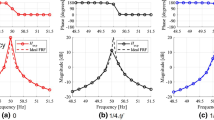Abstract
This paper deals with some aliasing effects in the time domain that can lead to unacceptable misestimations of modal parameters. When a frequency response function of a vibrating system is sampled and inverse Fourier transformed, the resulting impulse response is given by an infinite geometric series, the single term of which is the impulse response itself shifted in time. For this reason, some modal parameters, if estimated in the time domain, are biased; in particular, while the damping factor and the natural frequency are not influenced by the aliasing phenomenon, the magnitude and phase of the residue can be highly biased. Corrective terms are theoretically evaluated and their efficiency is shown in numerical simulations.
Sommario
In questo articolo e' presentato un metodo per correggere gli errori che si compiono nella stima di alcuni parametri modali, quando essi vengono ricavati nel dominio del tempo. Infatti se la funzione di risposta in frequenza e' ottenuta con eccitazioni particolari—quali ad esempio lo pseudo-random, lo stepped-sine a passo costante o lo sweep in frequenza-la risposta impulsiva, ottenuta per mezzo dell'antitrasformata discreta di Fourier, risulta periodica, con periodo pari all'inverso della spaziatura tra le righe spettrali. Cio' comporta un errore nella stima dell'ampiezza e della fase del residuo, mentre nessuna conseguenza si ha sulla frequenza naturale e sul fattore di smorzamento. L'errore sulle stime risulta tanto piu' grande, quanto meno smorzata e' la risposta impulsiva all'interno dell'intervallo di osservazione.
Partendo dall'inviluppo e dalla fase istantanea dei segnali complessi, ottenibili per mezzo della trasformata di Hilbert, si sono ricavati i termini correttivi sia per il modulo, che per la fase del residuo. La validita' delle correzioni e' mostrata con esempi numerici.
Similar content being viewed by others
References
Brigham E. O., The Fast Fourier Transform and its Applications, Prentice-Hall, London, 1988, pp. 282–288.
Gade, S. and Herlufsen, H., ‘Determination of structural damping using impulse response function’, Nordic Acoustical Meeting, June 1990, pp. 435–440.
Randall, R. B., Frequency Analysis, Bruel & Kjaer, 1987, pp. 44–45.
Gade, S. and Herlufsen, H., ‘Errors on impulse response function estimates and their corrections’, 15th Internat. Seminar on Modal Analysis, Leuven, 1990, pp. 1005–1015.
De Coulon F., Theorie et Traitment des Signaux, Georgi, Lausanne, 1984, pp. 208–218.
Papoulis A., Signal Analysis, McGraw-Hill, Singapore, 1985, pp. 24–25.
Bedrosian E., ‘The analytic signal representation of modulated waveforms’, Proc. IRE 50 (1962), 2071–2076.
Bedrosian E., ‘A product theorem for Hilbert transform’, Proc. IEEE 51 (1963), 868–869.
Rice S. O., ‘Envelopes of narrow-band signals’, Proc. IEEE 70 (7) (1982), 692–699.
Agneni, A. and Balis Crema, L., ‘Analytic signals in the damping coefficient estimation’, Proc. Internat. Conf. on Spacecraft Structures and Mechanical Testing, Noordwijk, The Netherlands, 1988, ESA SP-289, pp. 133–139.
Abramowitz M. and Stegun I. A., Handbook of Mathematical Functions, Dover, New York, 1972, pp. 228–233.
Ville J., ‘Theorie et applications de la notion de signal analytique’, Cables et Transmissions 2 (1948), 61–74.
Agneni A. and Balis Crema L., ‘Damping measurements from truncated signals via Hilbert transform’, Mech. System Signal Process. 3 (1) (1989), 1–13.
Harris F. J., ‘On the use of windows for harmonic analysis with discrete Fourier transform’, Proc. IEEE, 66 (1) (1978), 51–83.
Papoulis A., The Fourier Integral and Its Applications, McGraw-Hill, New York, 1962, pp. 25–29.
Bracewell R. N., The Fourier Transform and Its Applications, McGraw-Hill, New York, 1987, pp. 74–77.
Titchmarsch E. C., Introduction to the Theory of Fourier's Integrals, Clarendon Press, Oxford, 1937, pp. 119–123.
Tricomi F. G., Integral Equations, Dover, New York, 1985, pp. 166–173.
Agneni, A., ‘Hilbert and Hartley transforms in the time domain systems identification’, Aerotecnica-Missili Spazio 69 (1) (1990).
Agneni A. and Balis Crema L., ‘A time domain identification approach for low natural frequencies and light damping structures’, in Kirk C. L. and Junkins J. L. (eds) Dynamics of Flexible Structures, Computational Mechanics Publishers, Southampton, 1990, pp. 491–503.
Gabor D., ‘Theory of communications’, IEEE Jl 93 (1946), 429–457.
Vinh, T., ‘Vibration analysis and identification of non-linear structures’, Short Course Notes, Part 2, University of Manchester, 1985.
Tomlinson G. R., ‘Developments in the use of the Hilbert transform for detecting and quantifying non-linearity associated with frequency response functions’, Mech. System Signal Process. 1 (2) (1987), 151–171.
Tomlinson G. R. and Ahmed J., ‘Hilbert transform procedures for detecting and quantifying non-linearity in modal testing’, Meccanica 22 (1987), 123–132.
Agneni A. and Balis Crema L., ‘A new proposal for time domain SDOF components estimation’, Aerotecnica-Missili Spazio 65 (4) (1986), 167–175.
Author information
Authors and Affiliations
Rights and permissions
About this article
Cite this article
Agneni, A. Bias in modal parameters due to aliasing in the time domain. Meccanica 26, 221–228 (1992). https://doi.org/10.1007/BF00430939
Received:
Accepted:
Issue Date:
DOI: https://doi.org/10.1007/BF00430939




